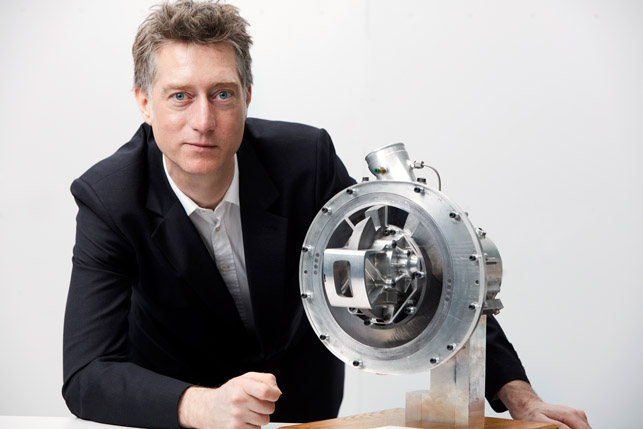
Steve Lindsey was named European Inventor Award 2017 finalist for his Blade Compressor
Despite inventing a new compressor, Lontra’s CEO Steve Lindsey admits that compression technology isn’t particularly glamorous. But, appearances aside, it’s a technology that performs a vital function, powering machines that affect almost every part of our lives. From air conditioning and fridges, factory tools and spray guns through to opening the doors on trains and buses, compressors are all around us.
Lindsey, who actually had no background or involvement in compressors until designing one himself, was drawn to the technology in the early 2000s when he discovered just how much power they consume.
“To begin with I didn’t know a great deal about compressors, like many people. And then I read that 10 per cent of electricity that is used within Europe across all industries goes into compressors. It’s a fantastically high figure and I realised that if you could make a difference to that, you could potentially make a big difference to energy usage across Europe,” claims Lindsey.
A natural problem-solver from a young age and always up for a challenge, Lindsey, who at the time was working as a management consultant having studied Chemistry at the University of Bristol a few years before, was curious as to whether he could delve into the world of compressors to create something more efficient.
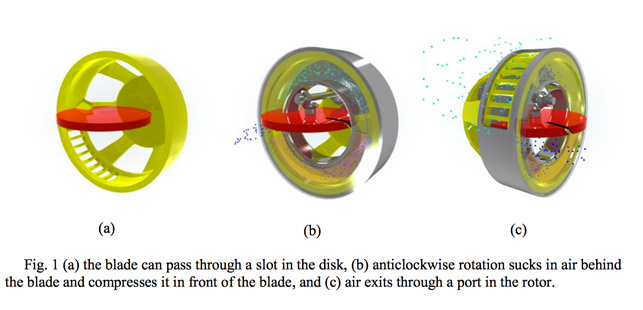
How it works
Patent search
His first port of call was the European Patent Office, which publishes all of its patents online for free and is a site that Lindsey has spent many an enjoyable hour trawling through in the past.
“I like reading patents because there is a fantastic amount of information on things that people have thought of before. And when I started looking at all the compressors out there I discovered that most were developed a bizarrely long time ago,” he comments.
“The first compressor was by an Italian engineer back in 1588, which is still in use today. Now the last big change was the screw compressor in 1935 and there hasn’t been anything major since then.”
Lindsey decided to go back to basics and looked in simple terms at what an air compressor is supposed to do. Similar to that of a car engine, the core principle is that, as a piston drops down, the volume above it gets bigger so it draws air into a cylinder and then as it goes up again, the volume becomes smaller as it compresses and pushes the air out.
Lindsey, who handily has the capability to visualise in 3D, envisioned a doughnut-shaped device that would continually compress air without the piston having to stop and change direction.
“It was the realisation that you could have two interlinking but off set rings which could then form a new geometry for a compressor.
“So as the blade, which is effectively a piston, rotates it draws in a volume of gas behind it. The magic bit is that as it gets back to the starting point, it catches up the volume of the gas that it induced behind the blade in the last cycle and now compresses it in front of the blade. A very simple but effi cient device that is always doing two things at once,” he describes.
Lindsey then called on a draughtsman friend to help draw up what he had visualised and to check it would actually work. He applied for a patent for his Blade Compressor and in 2004 he set up Lontra to commercialise it.
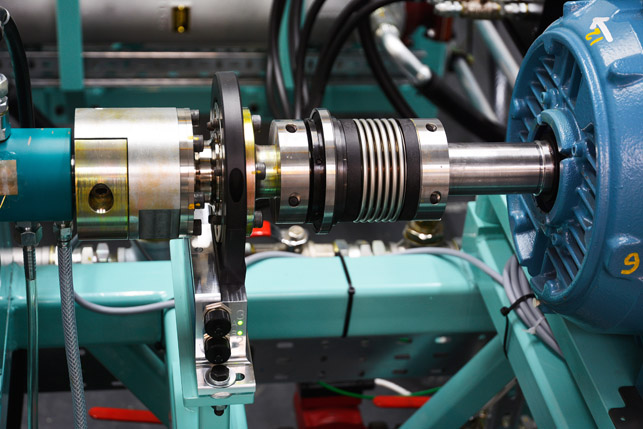
A sneak peek at some of the technology being used to innovate compressor designs at Lontra’s new Technology Centre near Coventry
Lontra targets wastewater industry
Although his invention is applicable to a range of industries, Lontra initially targeted the wastewater sector as it’s such an energy intensive area accounting for approximately one per cent of the UK’s total energy use.
“The main treatment in a wastewater system is actually natural bacteria. These micro-organisms break down the contaminants and to stay alive they need vast quantities of air, which is pumped in using traditional blowers and compressors. That is why so much electricity is used to bubble through sewage,” explains Lindsey.
With support from the Carbon Trust and Severn Trent Water, Lontra began carrying out market studies and developing a prototype for a site trial. Early work was carried out with engineers from Cosworth Technology, some of whom enjoyed the project so much that they decided to join the company, which Lindsey then set up in Napton, a village in the West Midlands.
Having created a 3D model of the compressor in Creo, in order to evaluate the design further and optimise its geometry, a thermodynamic and gas dynamic simulation software suite, BladeSim was written in-house by Lontra’s team of analysis engineers.
“This virtual testing provides insight into compressor operation and can eff ectively inform design decisions.
“We can run hundreds of tests every night which means you can really understand the machine. And the software suite they’ve built simulates everything from gaps where air leaks to thermals and wave dynamics,” explains Lindsey.
Lontra also had three test cells and multiple instrumented test rigs installed at its Napton facility to evaluate and develop the blade compressor design. With support from National Instruments and consultants Wiresmith Technology, this set-up is controlled using bespoke software programmed in LabVIEW.
Over a wide range of operating conditions, a correlation study was carried out to verify the simulated data from the Lontra BladeSim model with that of the measured data from the test bed. According to Lindsey, the results were pretty remarkable with mass flow predictions within two per cent of measured data without any “fudge” factors added to the model.
“Often when people design models like that the correlation is only good enough to be used directionally but with this you can actually make just a small tweak and then see what eff ect it has on efficiency with confidence that there will be a close match to real hardware.
“Our test cells also have fantastic repeatability with very little drift. With all 140 channels running we can sample at 25 kHz, which means in real terms that in a machine running at 4000rpm, you can freeze frame every degree and see what is happening. And it links back to the engineers’ simulation software so it enables them to deduce from the pressure trace how the machine is moving or distorting, which is pretty clever,” adds Lindsey.
With the prototype for Severn Trent Water built and thoroughly analysed, in 2012 it was ready for its trial installation at Worcester Wastewater Treatment Works. Here the compressor successfully ran for over 10,000 hours, the equivalent of more than three years of normal operation, and demonstrated more than a 20 per cent reduction in electricity consumption.
These results earned Lontra the award for the Most Innovative New Technology of the Year at the 2013 Water Industry Achievement Awards.
The company has racked up a number of awards since with the most recent achievement being that of Lindsey being nominated for the European Inventor Award 2017. He was one of just 15 finalists chosen from 600,000 active patents filed across Europe.
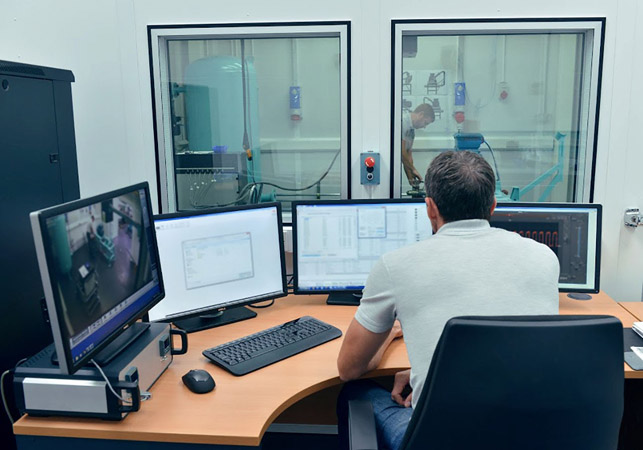
Lontra’s testing set-up is controlled using bespoke software programmed in LabVIEW
Lontra – New concepts in development
The invention has also made industry sit up and notice this small engineering company of just 20 employees. And as well as a multi-million pound deal with Swiss pump manufacturer Sulzer to supply its blade compressor to wastewater treatment plants, Lontra also recently won its second round of funding from the EU’s Horizon 2020 programme for research and innovation. This will help it introduce a new range of compressor technology into the pharmaceutical and food sectors, where it will be used for pneumatic conveyors.
With this new range, Lontra has partnered with Shield Group Engineering to help it streamline mass production. “I truly believe we can be globally competitive making stuff in the UK rather than outsourcing to China,” says Lindsey.
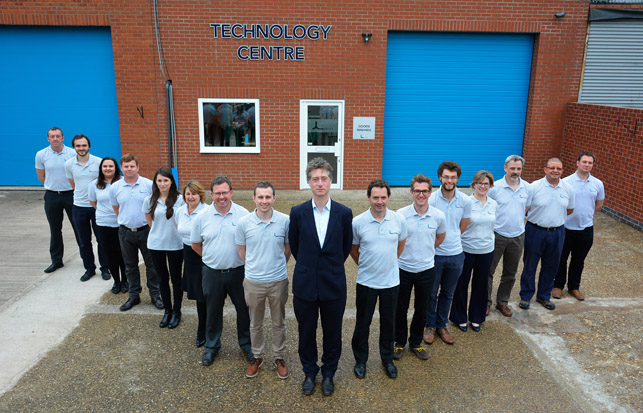
The Lontra team at its Napton facility
Of course, its simulation software and testing capability has proven invaluable in evaluating these new concepts and speeding up the development process. The engineering team has also further expanded its in-house BladeSim software to include the modelling and optimisation of exhaust and inlet silencers, which will actually help further improve the efficiency of its compressors.
“Right at the start of this journey I was told that compressors had been around a long time and there wasn’t anything new that could be done because it had all been done already. And I just don’t think that’s true.
“As we’ve done with compressors and now with silencing, if you just look at a system afresh you can make big steps forward especially with a good bunch of people and with the modelling and testing techniques that allow us to do things far beyond what people would have planned before.
“I believe that if you think diff erently about things you can really change the world. It’s quite exciting,” smiles Lindsey.






